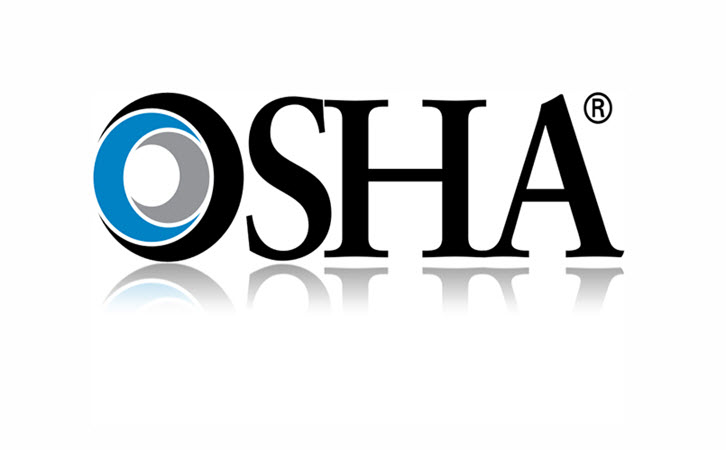By Phil Molé, MPH
On July 21, 2023, OSHA published its long-awaited final rule updating electronic injury and illness reporting requirements in its Recordkeeping Standard. Many stakeholders had been carefully following OSHA’s actions on this rulemaking because of its wide-reaching impacts, including expansion of electronic reporting obligations for many establishments. The final rule becomes effective on January 1, 2024, and the first reports under revised requirements are due March 2, 2024, which means that businesses will need to quickly prepare to meet updated requirements.
In what follows, we’ll break down the new final rule, explain what’s changing, and provide takeaways about how you can maintain compliance with revised electronic reporting requirements.
What’s Changing with the OSHA Recordkeeping Final Rule?
At a very high level, the OSHA final rule creates 4 different categories of electronic reporting obligations, depending on establishment size and industry sector, as shown in the chart below.
| Establishment Size (# of employees) | Industry Sector | Electronic Injury and Illness Reporting Requirements |
| <20 | All industries | No electronic reporting requirements |
| 20-249 | Listed in Appendix A of 29 CFR 1904 | Electronic 300A reporting |
| 100+ | Listed in Appendix B of 29 CFR 1904 | Electronic 300, 300A and 301 reporting |
| 250+ | All industries covered by Recordkeeping Standard | Electronic 300A reporting |
This blog will dive deeper into the changes brought by the final rule, the reasons OSHA made the changes, and how the revised requirements will impact employers a little later.
What is the Background of OSHA’s New Recordkeeping Final Rule?
But first, let’s recap background information about the Recordkeeping Standard and OSHA’s recent regulatory activity regarding the Standard.
One of the purposes of OSHA’s Recordkeeping Standard since it went into effect in 1971 has always been to make sure that OSHA could potentially collect injury and illness data from employers and use it to inform their regulatory and enforcement efforts. For many years, OSHA primarily collected this data from employers through the OSHA Data Initiative (ODI) survey. The ODI was a paper survey that required a great deal of time and effort on the part of both employers and OSHA to complete and process. It wasn’t a very efficient way to collect and process information for anyone involved, so in the internet age, OSHA began to consider more modern alternatives.
In May 2016, OSHA issued the final rule called “Improve Tracking of Workplace Injuries and Illnesses.” This rulemaking revised the Recordkeeping Standard to require some establishments, which were already subject to Recordkeeping requirements, to electronically transmit injury and illness data from Form 300A directly to OSHA. OSHA created the Injury Tracking Application (ITA) as a web-based platform for employers to use when transmitting their data.

While there had initially been discussion of publishing the 300A data, OSHA had not followed through on doing so –they are now revisiting that option.
The 2016 Recordkeeping revision requires establishments with NAIC codes subject to the Recordkeeping Standard with 250 or more employees, as well as establishments in certain high-risk industries listed in Appendix A of Subpart E with between 20 and 249 employees, to electronically transmit data from their Form 300A summaries to OSHA. If your establishment’s NAIC code is on that list, and you had 20 or more employees last year, you would need to submit electronic 300A data.
Keep in mind that according to OSHA, if the establishment’s NAIC code differs from the company’s primary NAIC code, the test comes down to whether the establishment’s NAIC code is subject to Recordkeeping and listed in Appendix A of Subpart E. Any establishments meeting both criteria would need to electronically report if they had a peak number of employees of 20 or greater in the previous calendar year. If the establishment has 250 or more employees and has a primary NAIC code that is subject to Recordkeeping (i.e., it’s not listed as “partially exempt” in a different Appendix A, this time of Subpart B), it is still subject to electronic reporting requirements based on the size threshold whether or not its NAIC code is listed among the higher risk industries in Appendix A of Subpart E.
All NAIC codes beginning in 31-33, which encompasses the whole manufacturing sector, are on that list. So, if you’re in the manufacturing sector, you are currently required to submit electronic 300A data for any establishments that had 20+ employees at any point last year. The reporting deadline is March 2 every year for the previous calendar year’s 300A data.
It’s interesting to note that the original 2016 final rule included a phased-in transition timeline in which some establishments would have needed to start annually submitting electronic data from Forms 300 and 301, as well. OSHA rescinded those additional 300 and 301 electronic reporting requirements via a 2019 final rule, and that seemed to end that issue. But as OSHA’s subsequent regulatory activities have shown, it’s not over yet.
OSHA’s 2021 Electronic Reporting Proposed Rule
OSHA published a Notice of Proposed Rulemaking (NPRM) in the Federal Register on March 30, 2022, as we previously blogged about.
The proposed rule would have pared down reporting requirements by removing the current requirement for establishments with 250 or more employees, not in a designated industry, to electronically submit information from their Form 300A to OSHA each year. But in other cases, it would expand reporting obligations by requiring some establishments whose NAIC codes are listed in a new Appendix B to submit electronic 300 and 301 information in addition to electronic 300A data. The NPRM also attracted a great deal of attention by reviving OSHA’s intent to publish injury and illness data it receives from employers via the ITA.
The public comment period for the NPRM closed on May 31, 2022. OSHA then started the long process of sorting through stakeholder feedback en route to developing a final rule, which brings us right up to the present moment.
How Does OSHA’s Recordkeeping Final Rule Change Electronic Reporting Requirements?
Revised Electronic Reporting Requirements
OSHA published the long-anticipated final rule updating the Recordkeeping Standard in the Federal Register on July 21, 2023.
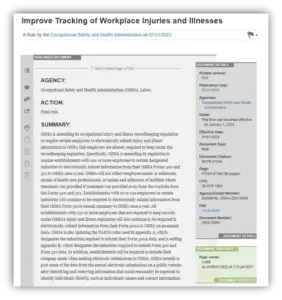
As expected, the final rule does change electronic reporting requirements for many establishments covered by the Recordkeeping Standard.
The way the final rule affects a specific establishment depends on the establishment’s industry sector and size, as follows:
- Establishments with 20 to 249 employees in certain high-risk industries listed in Appendix A of Subpart E of the Recordkeeping Standard will continue to be required to electronically submit information from their OSHA Form 300A annual summary to OSHA once a year, as they do today. However, the final rule also updates the list of NAIC codes in Appendix A. The retention of the current reporting requirement for these establishments is consistent with OSHA’s 2022 proposal. In the Federal Register notice for the final rule, OSHA notes that they had not received many stakeholder comments on this provision during the public comment period.
- Establishments with 100 or more employees in certain designated industries will need to electronically submit information from all three OSHA Forms (300, 300A and 301) to OSHA once a year. An employer would determine if their establishment is among these designated industries by seeing if their establishment’s NAIC code is listed in a new Appendix B to Subpart E of the Standard. Industry codes listed in Appendix B are a subset of those listed in Appendix A, and OSHA states that the criteria for including the designated industries in proposed appendix B to subpart E was based on a three-year average rate of Total Case Rate (TCR) in the Bureau of Labor Statistics (BLS) Survey of Occupational Injuries and Illnesses (SOII) for 2017, 2018, and 2019, of at least 3.5 cases per 100 full-time-employees. The images below show the full proposed Appendix B.
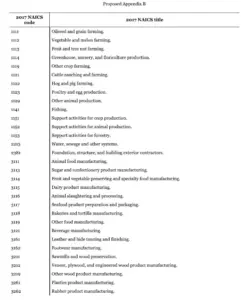
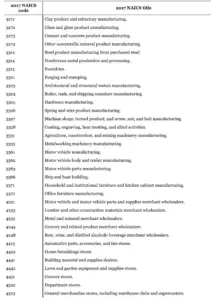
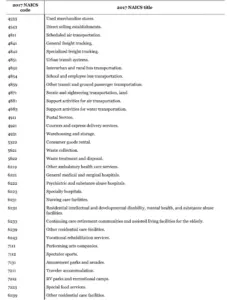
As you can probably guess, stakeholder opinion was divided on this issue. OSHA stated in the Federal Register notice that groups representing employees, such as unions, tended to support expanded reporting requirements at a lower threshold for the specific designated industries, because it would pull more employers into reporting requirements, and therefore increase the amount of data available on workplace hazards. Conversely, many businesses objected to the lower threshold, arguing that OSHA had not provided sufficient rationale for a lower threshold. OSHA agreed with commenters arguing that the expansion of reporting requirements for these establishments would improve the quality of safety data from industries where it was needed most, and additionally expressed confidence that employers at establishments with as few as 100 employees would have the ability and technical infrastructure to meet expanded reporting requirements. So, affected employers will now need to start preparing to meet these more stringent requirements.
- All establishments with 250 or more employees that are required to keep records under OSHA’s Recordkeeping Standard will also continue to be required to electronically submit information from their Form 300A to OSHA on an annual basis, as they do today. It should be noted that this is a difference between the final rule and the 2022 proposed rule, because the proposed rule would have removed the requirements for establishments with 250+ employees to submit electronic injury and illness reports unless they maintained requirements by virtue of being within a designated industry. Why did OSHA reverse course here? In the Federal Register notice for the final rule, OSHA notes that they received no comments specifically supporting the proposal to remove the reporting requirements for these establishments but did receive a number of comments opposing the proposal. Some stakeholders believed there was a need for continued oversight over large employers in low-hazard industries, and that because of the numbers of employees associated with these establishments, employer occupational injury and illness data from these workplaces could have an important role to play in protecting employee safety.
- Establishments required to submit electronic injury and illness data will need to include their legal company name in their submissions. OSHA intends for this requirement to improve the quality of data received from employers.
Here’s another look at the table summarizing the different categories of injury and illness reporting requirements under the final rule.
| Establishment Size (# of employees) | Industry Sector | Electronic Injury and Illness Reporting Requirements |
| <20 | All industries | No electronic reporting requirements |
| 20-249 | Listed in Appendix A of 29 CFR 1904 | Electronic 300A reporting |
| 100+ | Listed in Appendix B of 29 CFR 1904 | Electronic 300, 300A and 301 reporting |
| 250+ | All industries covered by Recordkeeping Standard | Electronic 300A reporting |
For affected establishments, the reporting deadline remains March 2nd of each year for reporting data for the previous calendar year.
Publication of Employer Injury and Illness Data
OSHA’s final rule retains the 2022 NPRM’s proposal that the agency will publish electronic injury and illness data received from employers. As mentioned earlier, OSHA had initially planned to publish employer injury data prior to publishing the original 2016 final rule that established electronic reporting requirements but didn’t move forward with the provision at that time.
When OSHA revived the plan for publishing data when issuing the 2022 proposed rule, many stakeholders expressed concern. During the public comment period, commenters pointed out that Forms 300 and 301 can often contain legally protected, confidential information about individuals and the medical treatment they received, and that if OSHA were to publish electronic 300 and 301 form information, they would therefore risk violating the privacy rights of affected employees.
In the Federal Register notice for the final rule, OSHA states that they will not collect employee names or addresses, names of health care professionals, or names and addresses of facilities where treatment was provided if treatment was provided away from the worksite from Forms 300 and 301. But what will OSHA do if employer-submitted forms contain this information? The Federal Register notice states that OSHA “plans to use automated de-identification technology, supplemented with some manual review of the data, to identify and remove information that could reasonably be expected to identify individuals directly from the fields the agency intends to publish,” and that “the agency will not publish text-based data until such information, if any, has been identified and removed.” The Federal Register notice also states that for coded data, OSHA plans to use an automated coding system to code the collected data, and that until the autocoding system has been tested and is in place, OSHA intends to only use and publish uncoded data. It remains to be seen how OSHA will sort out the details on how to strip out protected information, or how long it will take them to put what they consider to be effective enough systems in place to move forward with publishing employer injury and illness data.
OSHA maintains that the publication of data from Recordkeeping forms will enhance the effectiveness of the Recordkeeping Standard by improving access to key data about workplace injuries and illnesses. “Congress intended for the Occupational Safety and Health Act to include reporting procedures that would provide the agency and the public with an understanding of the safety and health problems workers face, and this rule is a big step in finally realizing that objective,” Assistant Secretary for Occupational Safety and Health Doug Parker states in a press release. “OSHA will use this data to intervene through strategic outreach and enforcement to reduce worker injuries and illnesses in high-hazard industries. The safety and health community will benefit from the insights this information will provide at the industry level, while workers and employers will be able to make more informed decisions about their workplace’s safety and health.”
How Should You Prepare for OSHA’s Electronic Reporting Final Rule?
The final rule goes into effect on January 1, 2024. In the Federal Register notice for the final rule, OSHA states that “because this final rule becomes effective on January 1, 2024, OSHA intends for March 2, 2024 to be the first submission deadline for the new information required to be submitted under this rule.” This means that establishments with reporting requirements under the final rule will need to be ready to submit their 2023 calendar year data by March 2, 2024, and need to start preparing today.
The best thing EHS professionals and company leadership can do to prepare is to start reassessing and improving their incident management practices right now. You’ll need reliable methods to ensure that you’re capturing and documenting all OSHA recordable injuries and illnesses and maintaining accurate injury and illness records. Complete and accurate injury and illness recordkeeping is important for proactive EHS management even aside from regulatory requirements, but it becomes even more urgent given the possibility that OSHA is preparing to make records for some establishments publicly available.
Modern safety management software can help by making it easy for you and your workers to report incidents, follow-up, and generate accurate OSHA forms. Even better, you’ll be able to access forms for multiple establishments from anywhere, at any time, and electronically submit forms to OSHA via the ITA.
If your current recordkeeping methods cause you to feel anxious about meeting OSHA’s revised electronic reporting requirements, now’s the time to start looking for better alternatives.
Let VelocityEHS Help!
Preparation for OSHA’s revised electronic reporting requirements will be easier if you have the right tools.
Our Safety Solution, part of our VelocityEHS Accelerate ® Platform, has incident management capabilities that can help you meet your Recordkeeping requirements with mobile incident reporting capabilities, and ability to quickly attach photographs and other documentation to the inspection record. We also help you easily complete Forms 300, 300A and 301. Best of all, we make it easy to generate electronic versions of all three OSHA forms for easy transmission to OSHA via the ITA. And if you have reporting obligations for multiple establishments, you can cut down on reporting time by putting information for multiple establishments on a single .csv file.
Visit our solution landing page for more information, or just contact us anytime.
